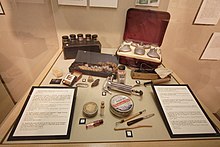Thanatopraxia

Thanatopraxie or thanatopraxis (from the Greek θανατος "death", at the same time Thanatos , god of death in Greek mythology; πρα Handwerkια "craft") includes all funeral activities that are necessary beyond the hygienic care of the dead in order to ensure an aesthetically and hygienically perfect laying out of a deceased. Thanatopractic treatment simplifies the pious farewell to the bereaved at the open coffin.
In the narrower sense, thanatopraxy includes, for example, the optical restoration of accident victims and the temporary preservation of a corpse for the purpose of transporting it abroad or laying it out in public in an open coffin over a longer period of time. Thanatology is the scientific basis of thanatopraxy . Executives are undertakers who are also qualified "thanatopractors" or "practical thanatologists".
The following areas of activity in thanatopraxia can be counted in particular:
- the restoration of the aesthetic appearance of the deceased by means of special cosmetics, restoration or reconstruction, especially if the body is disfigured by violence, accidental death, illness, discoloration, extraordinarily rapid decomposition, suicide, etc.
- delaying the decomposition of the corpse by embalming ( modern embalming ). The blood is replaced by an anti-decomposition agent, which is mostly based on formalin .
- the production of death masks for the deceased
